Why I Love The Story Arc
When I was first building the Fictionary story editing software, I knew I wanted to use the story arc as a focus for developing a systematic self-editing system. Why? Because the core structure of the story arc has been around for thousands of years and it’s the backbone of some of the world’s best stories.
Let’s look at how knowing story arc structure can help you write truly powerful, engaging stories.
What is the Narrative Arc?
In order to understand what the story arc is, we first need to explore the concept of the narrative arc.
If you’ve never heard of the narrative arc before, it’s a way of structuring stories that’s been around since before Aristotle was hanging out in ancient Greece. Put simply, you can split every story up into a narrative arc that has three acts.
Act 1: Setup
Your job in act one is to set up the story by introducing your protagonist and any necessary supporting characters. You also need to familiarise your readers with your story’s world, and your protagonist’s major character flaw (which will dictate the path of their internal arc, or their need to change).
Act 1 also contains the event that introduces the central conflict of the story (we’ll talk about The Inciting Incident in detail a little later), and the point at which your protagonist decides to leave their everyday world behind (otherwise known as Plot Point 1).
Act 2: Confrontation
Act 2 is a period of rising action, where three key elements gradually increase:
Tension
Conflict
Stakes
This makes things harder and harder for your protagonist. Other key moments in act 2 include a major turning point (otherwise known as the Midpoint) and the protagonist’s rock bottom moment (otherwise known as Plot Point 2).
Act 3: Resolution
The final act in any well-structured story is the resolution, so named because its function is to resolve the central conflict of the plot.
The two crucial things you must show your readers in the resolution are the sequence of scenes in which the protagonist either succeeds at achieving—or fails to achieve—their story goal (otherwise known as the climax), and a snapshot of what your protagonist’s life looks like after the climax (otherwise known as the Denouement, which is the resolution itself).
The narrative arc works because it provides a coherent structure for your story. What’s more, it’s a structure your reader has come to expect after reading, watching, and listening to stories for years.
Now you know what a narrative arc is, let’s dive deeper and look at the Fictionary Story Arc.
What is the Best Story Arc Template? The Fictionary Story Arc.
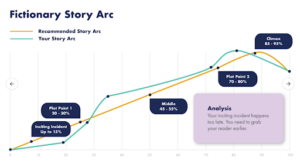
The Fictionary Story arc provides you with a simple five-step story structure you can follow when drafting, editing, and revising your novels.
The five key plot points in the Fictionary Story Arc are:
- The Inciting Incident
- Plot Point 1
- The Middle
- Plot Point 2
- The Climax
What do each of these points mean and how can I use them to tell better stories?
I’m glad you asked!
The Inciting Incident
Before you write your inciting incident, you need to set up your story word, protagonist’s flaw, and introduce the key players in their life, just like the narrative arc section suggests. The key here is to show the reader how the protagonist’s flaw is affecting their life in a negative way, and to show how they live life in their everyday world.
A note about the everyday world: In this context, everyday doesn’t necessarily mean normal. Depending on genre, your protagonist could be a powerful magical bounty hunter, or a dragon rider. Doesn’t matter, as long as that’s normal for them.
Once you’ve set up your everyday world, you need to destroy it!
That’s where the inciting incident comes in.
The two key components of the inciting incident are:
- The incident itself: this is a life-changing event that disrupts the protagonist’s world in such a way they can’t return to the way things used to be.
- The protagonist’s reaction: To appear human, your protagonist needs to react to this life-changing event. If you don’t give them time on the page to do this, they’ll feel wooden, flat, and underdeveloped.
Plot Point 1
After a period of reaction, your protagonist must make a decision. That decision is, should I stay where I am or leave my everyday world behind for good?
Remember: The inciting incident disrupts the everyday world in such a way they can’t return to it. If they can, there’s no story. With this in mind, your protagonist should reach the surprising, yet inevitable, conclusion they need to leave the everyday world behind once and for all.
The Middle
Around the middle of your novel, you should introduce a major turning point that increases the stakes (or the consequences should the protagonist fail to achieve the story goal), and shift the protagonist from a reactive to active state.
Up to this point in your story, your protagonist will have been floundering around like a fish out of water in this new world they find themselves in, making decisions based on their initial reactions to plot events. They don’t know enough about the new world to drive the action.
From the middle on, your protagonist needs to get proactive (i.e., actively drive and influence plot events).
Plot Point 2
After the middle, your protagonist starts to get used to their new life, and they might even be making big strides to achieving their story goal. But we can’t make it too easy for them.
Just when they think they’ve got the hang of this thing… WHAM!
Enter Plot Point 2. This is where something bad happens to your protagonist and they experience their lowest moment in the story. They’ll naturally question whether they have what it takes to achieve their story goal. Just after plot point 2, you’ll usually see another character giving the protagonist a lecture about how they’re exactly the right person to resolve the story’s central conflict.
They need this talking to restore their self-confidence, so they can face…
The Climax
The climax is a series of scenes where the protagonist either achieves, or fails to achieve, their story goal. The important thing to remember about your climax is, it need to contain the most:
Tension,
Conflict, and
The highest stakes for your protagonist
Once your protagonist succeeds or fails, there will be a short period of falling action where the reader catches their breath, followed by the resolution (or denouement), where you show what the protagonist’s life is like—and how much they’ve changed—as a result of going through the central story conflict.
Three Fantastic Examples of Story Arcs
You can find this story arc in stories throughout time. To show you the power of the story arc, we’re going to look at three examples from fiction.
The examples are:
- Beowulf
- Twilight by Stephenie Meyer
- The Da Vinci Code by Dan Brown
Beowulf’s Story Arc
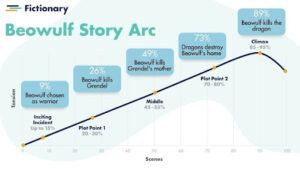
The Inciting Incident
Beowulf hears that the monster Grendel has attacked the Danes and King Hrothgar, and he’s chosen as a warrior to defeat Grendel.
This works as an inciting incident, because it disrupts Beowulf’s everyday world and introduces the central conflict of the story (the fact Beowulf battles monsters)
Plot Point 1
Beowulf kills Grendel.
This works because Beowulf is driven to stop Grendel, so he can’t stay in his everyday world and, by killing the monster, he accepts the central conflict of the story.
The Middle
Beowulf kills Grendel’s mother.
This works because it’s a false victory. Little does Beowulf know, the stakes are about to get a lot higher, and he’s going to have to be super active if he’s going to achieve the story goal.
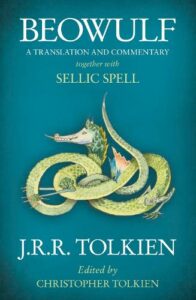
Plot Point 2
Dragons attack and destroy Beowulf’s home.
The loss of Beowulf’s home works so well, because it marks his lowest ebb, and his darkest moment.
The Climax
Beowulf kills the dragon, so we think this is going to be a story with a “happy ending”, but, in a shocking, last-minute twist, Beowulf dies from his wounds.
These scenes definitely have the greatest conflict and tension, and the highest stakes (stakes that result in Beowulf’s death). The resolution comes in the form of Beowulf’s people commemorating him as a true hero.
Twilight’s Story Arc
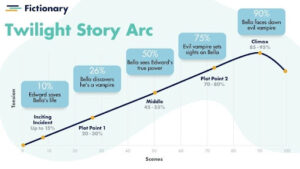
The Inciting Incident
Edward saves Bella’s life.
This works because this is the moment Bella’s everyday world changes forever. She witnesses Edward’s inhuman speed and strength, knows he’s different, but doesn’t know how yet.
Plot Point 1
Bella finds out Edward is a vampire. The question becomes, should she stay with him? The surprising, yet inevitable answer is, yes.
This works because Bella already has strong feelings for Edward. She can’t go back to the way things were before because it would be impossible for her to forget that she met him, and she would be miserable without him in her life now.
The Middle
Bella sees Edward’s true power.
This midpoint marks a shift in the tone of the book and the stakes increase for Bella from this point on.
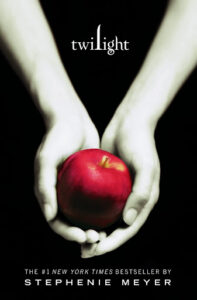
Plot Point 2
James (one of the villainous vampires) sets his sights on Bella.
This works as an all is lost moment, because Bella is in mortal danger.
The Climax
Bella confronts James (and Edward eventually kills him).
As the story arc suggests, these scenes have the highest tension, conflict and stakes.
The Da Vinci Code’s Story Arc
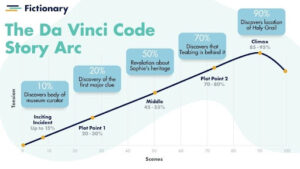
The Inciting Incident
Robert Langdon arrives at the Louvre in Paris and discovers someone has murdered the museum curator.
At its heart, The Da Vinci Code is a thriller, and it’s common to have the discovery of a dead body at this point, because the protagonist is compelled to solve the case.
Plot Point 1
Langdon discovers the first major clue, which is the cryptex hidden in a painting at the Louvre. The question he faces is, should I investigate? Langdon is also a suspect, so he has no choice but to investigate. He decides to go on the run (with cryptographer Sophie Neveu) in an attempt to clear his name.
This works because, now he’s on the run, Langdon can’t go back to his everyday world.
The Middle
Langdon and Sophie meet up with Teabing, who reveals that Sophie is a descendant of Jesus Christ and Mary Magdalene.
This adds a personal aspect to the case and raises the stakes.
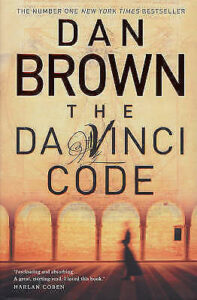
Plot Point 2
Teabing betrays Langdon and Sophie.
Langdon (who trusted Teabing) is rocked by his betrayal, and this brings about Langdon’s lowest moment. It also sets up the climax.
The Climax
Langdon and Sophie finally discover the location of The Holy Grail, and Langdon’s ingenuity leads to Teabing’s arrest.
And thus, the central conflict is resolved amidst the biggest tension, greatest conflict and highest stakes.
Conclusion
It’s time to stop struggling to make your story work. The story arc activates readers for a reason. It’s been around for over 2000 years and it’s the form our brains love. Why not evaluate your story and see if you can make your story better? You’ve got nothing to lose by trying it out.

